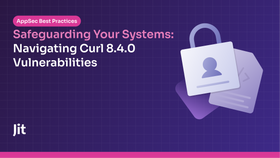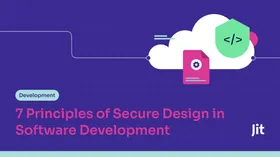Application Security Policies to Automate Vulnerability Triage and Management [PDF download]
Updated February 25, 2025.
![Application Security Policies to Automate Vulnerability Triage and Management [PDF download]](https://entail.jit.io/en-assets/jit/fit-in/700x700/Application_Security-1739896057069.png)
Skipping an Application Security Policy (ASP) leaves your organization vulnerable to modern threats like data breaches, advanced persistent threats, and supply chain attacks. The increasing complexity of applications, driven by microservices and third-party integrations, creates hidden risks that only a unified security policy can help detect and mitigate.
In 2024, prioritizing vulnerabilities ranked among the top three challenges for 60% of organizations working to secure their applications. Organizations need streamlined processes and automation to stay on top of the constant slew of vulnerabilities and risks. If you’re scaling quickly or dealing with the pressure of tight releases, a comprehensive application security policy can help you simplify AppSec through automation.
What Is an Application Security Policy?
An application security policy (ASP) operationalizes your security standards to protect your web applications effectively. This policy translates into specific, actionable protocols that automate security measures. It also helps set clear roles, responsibilities, and expectations for your development and security team. An effective ASP should include the following:
- Secure coding standards: Protocols that dictate how codes should be written to minimize vulnerabilities. For example, requiring input validation and using parameterized queries can prevent common attack types like SQL injection.
- Vulnerability management processes: Steps for identifying, assessing, and addressing application security flaws. This process includes vulnerability prioritization and efficiently triaging them to the appropriate teams for targeted remediation.
- Code review practices: Peer reviews and automated code analysis tools to help identify potential security flaws before code is merged into the main branch.
- Access control policies: Guidelines to define and enforce who can access specific applications, data, and systems. Measures include multi-factor authentication (MFA), role-based access control (RBAC), and context-aware access rules.
Why You Need an Application Security Policy
Modern software development moves quickly, with constant updates, rapid deployment cycles, and increasingly complex systems. Microservices, APIs, and third-party integrations create environments that are hard to secure. At the same time, the rate of deployments means new code is constantly being introduced, making it nearly impossible to manage security risks manually.
AppSec policies help manage these challenges by automating critical security workflows like vulnerability detection, prioritization, triage, and remediation. Automated security checks, branch protection rules, and context-aware triaging bring consistency and efficiency. An ASP also minimizes the costly and time-consuming effort of rolling out fixes after deployment. Without these mechanisms, the gap between development velocity and security becomes impossible to close.
How to Establish an Application Security Policy in 9 Steps
Creating a strong ASP is a two-phase process: first, you plan and then implement. This section has nine steps. The first four steps lay the groundwork, while the last five focus on implementing these plans and monitoring outcomes.
1. Align with Business Objectives and Regulations
Start by mapping your organization’s strategic goals and risk appetite to industry regulations. Pinpoint the most critical assets and determine which compliance requirements apply to them. This alignment helps prioritize security investments so that protective measures directly support broader business priorities rather than existing as stand-alone mandates.
2. Identify and Classify Assets
To focus your security efforts effectively, you need an inventory of all critical information and systems. Catalog your applications, data repositories, and supporting infrastructure. Label them based on sensitivity (internal use only, confidential, mission-critical) and potential impact if compromised.
You can manage this with Jit Resources, which uses the Jit Context Engine to map and prioritize your business-critical services automatically. It offers auto-discovery and risk scoring of code resources and options to label your most critical resources manually.
Classification enables you to quantify cyber risk and focus resources where they matter most, avoiding oversecuring assets with minimal risk or under-securing those with higher stakes.
3. Define Clear Ownership and Responsibilities
A successful policy clarifies who manages each portion of the security pie. Specify which teams or individuals handle threat monitoring, code scanning, patch management, incident response, and user training. Provide explicit guidelines so each team knows its responsibilities, performance expectations, and escalation paths in case of a threat or breach. These guidelines eliminate confusion, promote accountability, and streamline decision-making when issues emerge.
4. Align with Official Security Standards
Establish guidelines for secure coding, code reviews, and design principles that mitigate known vulnerabilities, referencing official security frameworks like the OWASP Top 10 or NIST’s SSDF.
Include key practices such as:
Sanitizing inputs to prevent injection attacks.
Manage sessions securely by setting reasonable session expiration times to reduce the risk of session hijacking.
Use secure HTTP headers to limit the chance of clickjacking and other cross-site scripting issues.
Enforce server-side access controls, where each function checks user rights before performing actions.
For infrastructure, go beyond the basics by incorporating layered defense mechanisms – such as using microservices to isolate critical components, encrypting data across each stack layer, and applying container security best practices.
Early-stage threat modeling can help uncover architectural weak points and shape decisions around data flows, identity management, cryptographic controls, and zero-trust principles.
5. Establish Secure Development and Deployment Practices
Security principles should guide every software development lifecycle (SDLC) phase. Rather than sprinkling security checks at the end, introduce CI/CD gates:
Add branch protection rules to prevent insecure code from being merged into your main codebase;
Enforce a minimum threshold for test coverage;
Require that the code passes all unit tests before progressing to the next pipeline stage;
Automatically scan for hard-coded secrets or credentials in code commits.
Use software composition analysis (SCA) tools to track and update dependencies automatically and ensure all new ones are reviewed and tested before integration. Leverage static application security testing (SAST) to analyze source code and dynamic application security testing (DAST) to test running applications. You can also use ephemeral test environments that spin up and are later discarded for each feature branch. These offer a secure and isolated testing field for new changes.
6. Set Access Control Standards
Only the right people, processes, or services should have access to sensitive data and systems. Granular access controls limit who can view, edit, or deploy critical systems. For more critical systems, consider context-based or ephemeral credentials, where access is granted for a limited time or specific use case.
Layer multi-factor authentication (MFA) on top of these controls to protect privileged and high-impact accounts. Periodic privilege reviews and automated revocation workflows prevent “permission creep” as personnel move between teams or gain new responsibilities.
7. Integrate Vulnerability Prioritization and Triage
Instead of overwhelming teams with endless vulnerability reports, prioritize issues based on runtime context. For example, vulnerabilities in production systems or those exposed to the internet should be flagged and addressed first.
Look for tools that automatically evaluate security issues against defined risk thresholds, such as exposure levels or criticality, and route high-priority issues directly to the relevant teams for resolution. This way, production-critical vulnerabilities are triaged and remediated quickly, and you’re not wasting time on low-risk or non-actionable findings.
The Jit Product Security Platform Tools like Jit enables this workflow by combining runtime context, automated triaging, and developer-focused experiences. Jit brings together open-source and proprietary scanners under a Security Plan as Code (SaC) model to identify and escalate issues tied to critical assets while also providing automated remediation suggestions.
8. Monitor Security Metrics and Performance
You can’t improve what you don’t measure. Track key metrics, such as mean time to detect (MTTD), mean time to remediate (MTTR), patch deployment rates, or the frequency of failed login attempts. Dashboards and regular reports can keep your teams informed, encouraging data-driven adjustments in training, audits, or tooling strategies.
9. Formulate an Incident Response Plan
Advanced attacks can challenge even a well-structured policy. Develop a plan detailing how to identify, contain, and eliminate breaches as efficiently as possible. Outline communication strategies for internal teams, external partners, and customers.
A tool like TheHive can streamline incident handling by automating tasks such as alert triage, evidence collection, and cross-department coordination. Review the plan regularly and run tabletop exercises to verify its real-world efficacy.
Enforcing and Managing an Application Security Policy
Enforcing an application security policy requires persistent oversight, a security-first culture, and integrated tooling. You should embed application security into your development process to support velocity rather than hinder it. AppSec scanners should be easy to implement and customize so teams can adopt them without disruption.
Strengthen your AppSec strategy by adding optional policies that limit developers’ ability to ignore critical security findings before pushing their code. You can also use branch protection rules to block insecure code changes from being merged. Automating vulnerability prioritization and triage based on runtime risk thresholds ensures that high-risk issues are automatically routed to the appropriate team for resolution.
Jit enables security teams to integrate these practices into their workflows with automated orchestration, open-source integrations, and developer-friendly feedback. It simplifies the integration of security practices and policy checks into daily development tasks, delivering immediate insights into pull requests. This replaces massive end-of-sprint scans with continuous checks that preserve velocity.
Elevate your security strategy by downloading our complete Essential Application Security Policy PDF. This resource will help you craft a policy that aligns with your needs and enhances your team’s security capabilities.









